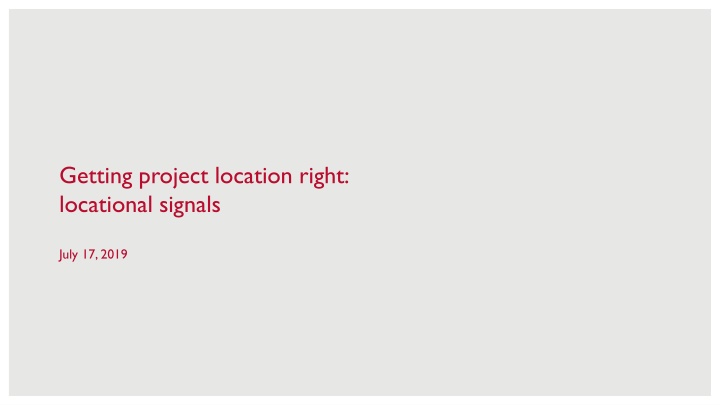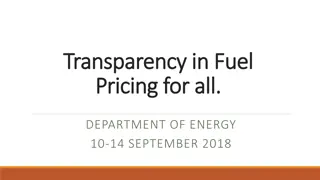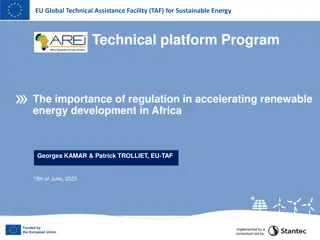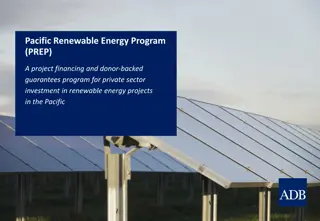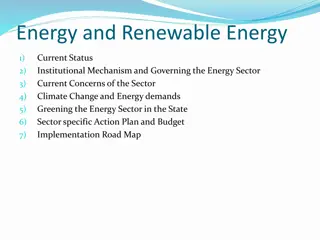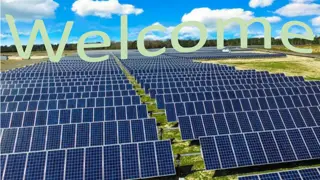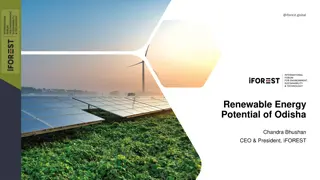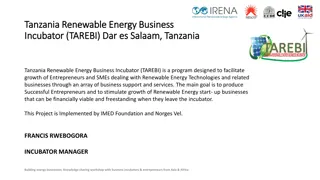Effective Strategies for Locational Signals in Renewable Energy Projects
Locational signals play a crucial role in steering renewable energy project constructions to specific areas, aiding in grid optimization and resource utilization. Strategies like bid bonuses, penalties, and maximum capacity quotas help manage integration challenges and ensure sustainable deployment of renewable energy sources. This article explores the importance of locational signals, their impact on project siting, and various incentives used in competitive procurement designs to enhance energy transition efforts.
Download Presentation

Please find below an Image/Link to download the presentation.
The content on the website is provided AS IS for your information and personal use only. It may not be sold, licensed, or shared on other websites without obtaining consent from the author.If you encounter any issues during the download, it is possible that the publisher has removed the file from their server.
You are allowed to download the files provided on this website for personal or commercial use, subject to the condition that they are used lawfully. All files are the property of their respective owners.
The content on the website is provided AS IS for your information and personal use only. It may not be sold, licensed, or shared on other websites without obtaining consent from the author.
E N D
Presentation Transcript
Getting project location right: locational signals July 17, 2019
System integration becomes more relevant with an increasing share of renewable energy New challenges emerge System integration costs and policy/support costs are different. System integration readiness: Insufficient capacity to connect electricity supply and demand Cost of capital (debt, equity) + Example: Germany Electricity production costs (focus of policy/support costs) Grid expansion costs related to RE = + Costs of control and balancing energy related to RE, including the provision of capacity Transaction costs + + Producer rent + In developing countries with increasing energy demand, stress on the grid is accentuated as RE deployment gains pace. System costs of RE generation = 2
Locational signals: Why are they important Overall: Good to have a general strategy on how to site projects, locational signals become particularly important if high RE and/or weak grids Site-agnostic schemes tend to concentrate the development of projects to resource-rich locations, which can overload the grid infrastructure and create competition for land usage. Aim of locational signals: Steering the construction of projects to specific areas to avoid the concentration of projects in certain areas (e.g. due to system integration concerns) Options for locational incentives could include bonus/penalty to bids located in areas with available/insufficient grid capacities RE development zones maximum capacity quotas in certain areas site-specific auctions 3
A continuum of incorporating locational steering in competitive procurement design Site- agnostic auction Site- specific auction Bid bonus/ penalty REDZ Maximum capacity quota Zones with simpler environmen tal/grid connection approval process Bonus applied to bids in places with available grid capacity or power capacity needs RE projects are built everywhere (i.e. best resources sites) Authorities select a site according to grid and land availability Capacity limits (quotas) are defined in certain areas Hard locational signals No locational signals Most RE auctions Germany, Mexico South Africa Kasachstan, Germany Zambia, Germany 4
Bid bonusses and penalties reflect the value of electricity or grid restrictions Mexico Expected price differences Bid bonus/ penalty + 5 / MWh Bonus applied to bids in places with available grid capacity or power capacity needs 5 / MWh - 35 / MWh 40 / MWh 40 / MWh 35 / MWh Gebot 1, price zone A Adapted bid price Adapted bid price Gebot 2, price zone B No locational signals Germany Distribution network component Joint auctions wind and solar PV Malus for bids in areas, where additional RE capacities would require grid extension Germany, Mexico 5
Different zones have different capacity quotas Kazakhstan Segments <10 MW District Substation Max. grid capacitiy # new grid connections Maximum capacity quota Astrakhanskiy district Urman 7 MW - Sandyktauskiy district Balkashino 7 MW - Capacity limits (quotas) are defined in certain areas District - Gabit Musrepov Kuibyshevsk aya 14 MW - Hard locational signals Germany Onshore wind Grid extension area : up to 900 MW may be added 2800 MW yearly auction volume Kazakhstan, Germany Quellen Bayan 2018 (USAID); BNetzA 6
Site-specific auctions can effectively take grid restrictions into account Zambia Scaling Solar / Germany Offshore wind Site- specific auction Auctioneer Pre-development by authorities may entail: Bidder 1 Project site Selected & pre-developed Authorities select a site according to grid and land availability Grid connection Environmental assessment Resource assessment Lease contract Bidder 2 Bidder 3 Bidder 4 Hard locational signals Zambia, Germany 7
How to create meaningful locational signals (1/III) Benefits of locational signals Reduced total system costs by identifying an optimal trade-off between required grid extensions/reinforcements and RE generation costs Tool Production Cost Modelling Tool which optimizes the unit commitment and economic dispatch of the power generation fleet taking into account transmission constraints of the grid Key input data 1. Todays and future expected hourly load time series for each node of the transmission grid 2. Techno-economic parameters of power plants connected to each system node incl. installed capacity, fuel cost, efficiency, min. stable generation level, max. ramp-rates, must-run requirements, etc.) 3. Transmission capacity between nodes of the transmission system 4. Potential hourly RE generation over the year Ideal case: hourly time-series available for each node of the transmission system 8
How to create meaningful locational signals (1I/III) Output for each investigated scenario Total annual system costs Optimal hourly dispatch schedule for power plants at each node of the system Hourly power transmission between system nodes and grid congestion Hourly locational marginal prices (LMP) for each system node Comparing results between investigated scenarios shows saving/additional costs if RE project is installed at system node A compared to system node B or even not at all Based on results, locational signals (bonus/malus) can be defined 9
How to create meaningful locational signals (1II/III) Translating optimal location out into incentives Price-based: bonus/malus Quantity-based: capacity quota Objective: define at which nodes bid bonus or malus is applied. Cost delta between base case (no optimization of RE location) and optimal case for each system node: If lower cost: bonus applied to bids at that node Level of bonus < node cost delta (otherwise no savings for consumers) Objective: Identify maximum wind or solar capacity in certain system nodes Several options: Ex.1: define capacity quotas at all nodes (based on the output of the modeling) Ex.2: allow 10% of target RE capacity to be built at best resource sites Define optimal capacity allocation for the remaining 90% of target RE capacity 10
Effectiveness of instruments is influenced by a lack of resources or lack of information available to authorities Site-specific tenders: lack of resources available to authorities Morocco and UAE: The sites for solar projects were selected as part of a plan that accounted for the investments needed in grid infrastructure. Quotas: lack of oversight over the whole system Grid operator needs to have knowledge of connection conditions and available capacity for each substation, coordination with auctioneer is also key. Bonus: lack of information with sufficient spatial resolution on system integration costs System integration cost data would need to be modelled to identify the need for more regional or time-based tariff differentiation. Be aware! Inadequate government planning can increase project costs, support costs and overall system costs. 11
Interactive Session Exercise 3: Designing an auction with locational steering July 17, 2019 12
Interactive Session Interactive Session: Instructions AIM: Identify suitable auction design choices for fictive countries Activity: Groups with 7-9 participants from difference institutions represent one fictional case country and identify suitable design from a menu of design choices Appoint someone from your group to guide the discussion and present the findings Note down key findings from your discussions on the assignment sheets Timing: 20 minutes design within group, 40 minutes presentation & discussion with large audience 13
Interactive Session Interactive Session - Instructions Please discuss to advantages and disadvantages of the different options to include locational signals and recommend a locational signal for your fictitious country: A) Site- agnostic auction F) B) C) D) Site- specific auction Bid bonus/ penalty REDZ Maximum capacity quota Zones with simpler environmen tal/grid connection approval process Bonus applied to bids in places with available grid capacity or power capacity needs RE projects are built everywhere (i.e. best resources sites) Authorities select a site according to grid and land availability Capacity limits (quotas) are defined in certain areas 14
Interactive Session list +/- of the different options for different countries and recommend one Country Site- agnostic auction Bid bonus/ penalty RE Develop. Zones Maximum capacity quota Site- specific auction Your choice for country Country 1 Country 2 Country 3 Country 4 9/14/2024 15
Interactive Session Interactive Session Case countries (1/11) Country 1 Regional variation of RE resources, excellent RE resources in West, very good reserves in East and North, medium-quality RE resources in South Most demand centers and industry are located in the East of the country Transmission lines linking the country exist but wave rather small capacities Transmission line extension between West and East is planned, but will approximately take 9 years, transmission line extension between North and East is planned, but will take approximately 6 years. Grid capacities within East are strong Government does not own much land with good RE resources Country 2 RE resources (solar and wind) as well as demand centers (cities, industry) distributed evenly over the country Transmission lines linking the country exist and still have capacity to include more RE Clarity for bidders on rules & regulation Already several project developers active with some already pre-developed projects 16
Interactive Session Interactive Session Case countries (11/11) Country 3 Large country with vast land. Strong regional variation of RE resources between and within regions. Transmission lines linking the country exist but wave rather small capacities An additional transmission line extension is in construction and to be commissioned in 4 years Permit for RE projects are complex to obtain Government owns land with high RE resources close to new transmission lines Country 4 Large country with vast land. Not strong regional variation of RE resources. Most demand centers and industry are in the East of the country Transmission lines linking the country are rare, two new transmission lines with higher capacity connecting the North with the East with new substations have just been commissioned There is overcapacity in the South of the country 17
